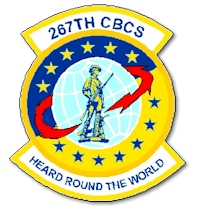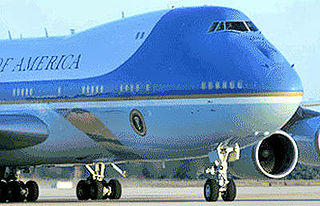
The Royal Australian Air Force's No 1 Combat Communications Squadron (1CCS), is a Squadron within No 395 Expeditionary Combat Support Wing, and is responsible for the provision of expeditionary Communications and Information Systems to support Air Force and Australian Defence Force operations and exercises.

The Georgia Air National Guard is the air force militia of the U.S. state of Georgia. It is, along with the Georgia Army National Guard, an element of the Georgia National Guard.

The 139th Airlift Wing is a unit of the Missouri Air National Guard, stationed at Rosecrans Air National Guard Base, St. Joseph, Missouri. If activated to federal service, the Wing is gained by the United States Air Force Air Mobility Command.

The 111th Attack Wing is a unit of the Pennsylvania Air National Guard, stationed at Horsham Air National Guard Station, Willow Grove, Pennsylvania. If activated to federal service, the Wing is gained by the United States Air Force Air Combat Command. It provides protection of life, property, and the preservation of peace and order when tasked to do so by state or federal authorities. The Wing also provides operational and support units, as well as qualified personnel, to support wartime tasking and contingency commitments of any nature.

The 105th Airlift Wing is a unit of the New York Air National Guard, stationed at Stewart Air National Guard Base, Newburgh, New York. If activated to federal service, the Wing will be gained by & brought under the command of the United States Air Force Air Mobility Command. It provides highly skilled people and operationally ready equipment necessary to meet U.S. inter-theater airlift and expeditionary combat support commitments.

The 507th Air Refueling Wing is a reserve component flying unit of the United States Air Force. It is assigned to Fourth Air Force of Air Force Reserve Command, stationed at Tinker Air Force Base, Oklahoma with elements at Altus Air Force Base, Oklahoma. The 507th ARW executes air refueling, airlift, and training in support of Air Mobility Command and U.S. Strategic Command's national emergency war order requirements. The wing employs approximately 1,100 men and women made up of a mix of Traditional Reservists, full-time Air Reserve Technicians, AGRs and Air Force civilians. The wing also provides mission support for all other reserve units stationed at Tinker AFB.

The 187th Fighter Wing is a unit of the Alabama Air National Guard, assigned to Dannelly Field, Alabama. If activated to federal service in the United States Air Force, the 187 FW is operationally-gained by the Air Combat Command (ACC).

The 160th Air Refueling Group is an inactive unit of the Ohio Air National Guard. It was last stationed at Rickenbacker Air National Guard Base, Columbus, Ohio. The 160th ARW was inactivated on 1 October 1993.

The 169th Fighter Wing is a unit of the South Carolina Air National Guard, stationed at McEntire Joint National Guard Base, Columbia, South Carolina. If activated to federal service, the Wing is gained by the United States Air Force Air Combat Command.

The Maine Air National Guard is the air force militia of the State of Maine, United States of America. It is, along with the Maine Army National Guard, an element of the Maine National Guard.

The Florida Air National Guard is the air force militia of the State of Florida and, as part of the air force militia of the United States, is part of the Air National Guard. On a state level, along with the Florida Army National Guard, it is also an element of the Florida National Guard.

The United States Air Force's 267th Combat Communications Squadron is an Air National Guard combat communications unit located at Otis Air National Guard Base, Massachusetts.

The 133d Air Refueling Squadron is a unit of the New Hampshire Air National Guard 157th Air Refueling Wing located at Pease Air National Guard Base, Portsmouth, New Hampshire, United States. The 133d is equipped with the KC-135R Stratotanker.

The 5th Combat Communications Group is a specialized unit of the United States Air Force. The 5th Mob is currently based at Robins Air Force Base in Warner Robins, Georgia. Its current structure is made up of two active duty Combat Communications Squadrons and the 5th Combat Communications Support Squadron, which handles such activities as the group's Mobility Training Program.

The United States Air Force's 269th Combat Communications Squadron is an Ohio Air National Guard combat communications unit located at Springfield Air National Guard Base, Ohio.

The 254th Combat Communications Group a unit of the Texas Air National Guard located at Hensley Field, Dallas, Texas. If activated to federal service, the wing is gained by the Air Combat Command.

The 252d Combat Cyberspace Operations Group is a unit of the Washington Air National Guard at Camp Murray, Tacoma, Washington. It is assigned to the 194th Regional Support Wing. The 252d has squadrons at Camp Murray, and two geographically separated units at Fairchild Air Force Base.

The 202nd Engineering Installation Squadron is a unit of the Georgia Air National Guard. The installation, repair and serviceability of sophisticated command, control, communications, intelligence, intelligence, surveillance, and air reconnaissance to Air Force installations worldwide is the responsibility of the men and women of the 202nd Engineering Installation Squadron.

The 241st Air Traffic Control Squadron is a unit of the Missouri Air National Guard, stationed at Rosecrans Air National Guard Base, St. Joseph, Missouri. If activated to federal service, the unit is gained by the United States Air Force Air Combat Command.

























